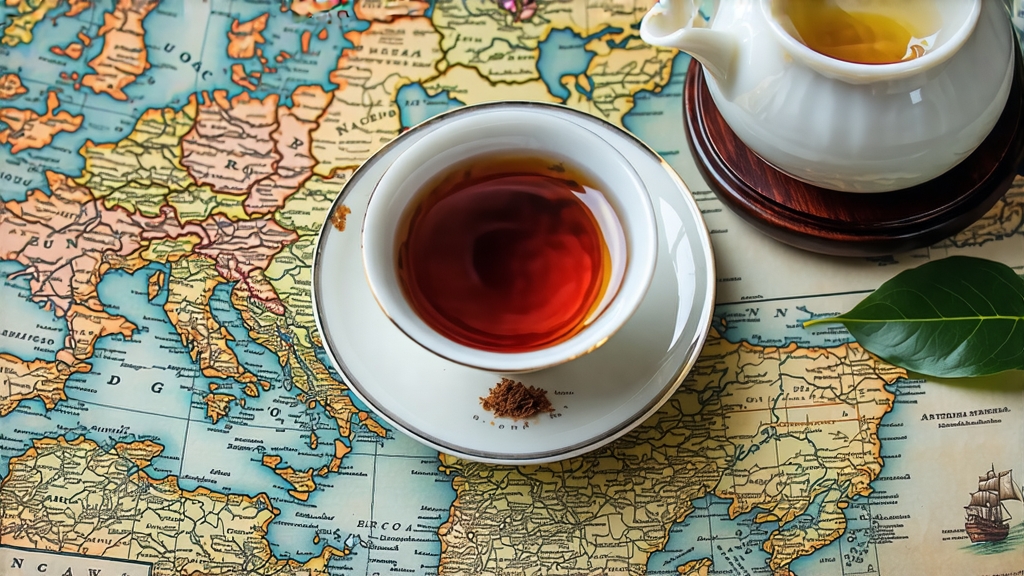
Among the six great families of Chinese tea, dark tea—hei cha—stands apart because it refuses to stand still. While green tea chases the freshness of spring, hei cha travels through time, fermenting, breathing, even blooming. Of all its celebrated members, none carries a more romantic passport than Fu brick, the brick-shaped tea that once financed caravans, cured border appetites, and still hides a microscopic garden of golden flowers inside its jet-black body.
A 2000-year road in 2000 words
Fu brick’s story begins not in a garden but on a trade route. During the Tang dynasty (618-907), imperial edicts banned private horse trading on the northwestern frontier. Resourceful merchants compressed cheap, coarse Hunan tea into bricks, lashed them to pack animals, and swapped the durable cargo for Tibetan warhorses. The bricks survived Himalayan blizzards, and—almost by accident—arrived tasting smoother, sweeter, and mysteriously fragrant. By the Ming (1368-1644) the court formalized this “Tea-for-Horse” policy, building the 3000-km-long Ancient Tea-Horse Road. Fu county, a small garrison town in Shaanxi, became the official checkpoint where tea was re-pressed, stamped with the Chinese character “Fu” (福, blessing), and granted imperial tax seals. Thus the tea, and the town, gave the world Fu brick.
Terroir: where the leaf learns to travel
Authentic Fu brick starts with raw leaves from the humid, granite-soiled mountains of central Hunan—Anhua, Taohuajiang, and Xinhuang counties. The cultivar is invariably Yun Da Ye (large-leaf cloud cultivar), a hardy camellia sinensis var. assamica that accumulates polyphenols and survives late frosts. After the early-May harvest, leaves are sun-withered until they lose the green bite, then pan-fired at 280 °C for eight minutes to arrest oxidation. What follows is not a single step but a choreography of piling, pressing, and flowering that turns green into black and leaf into medicine.
Crafting the brick: science in a steam cloud
- Pile-fermentation (渥堆): The fixed leaves are heaped 70 cm high in humid rooms. Indigenous microbes—primarily Aspergillus niger, Blastobotrys adeninivorans, and a yeast battalion—raise the internal temperature to 55 °C within 36 hours. Workers turn the pile every two days, sprinkling water to maintain 75 % humidity. After 15–20 days the leaf color shifts from olive to coffee-brown, and grassy aromatics give way to damp bark and dried jujube.
- Stewing (汽蒸): The fermented leaf is steamed for 90 seconds at 105 °C, softening cellulose so that stems bend without breaking. The hot mass is immediately transferred to pine-lined wooden molds 35 cm × 18 cm × 4 cm.
- Flower inoculation (发花): Here Fu brick diverges from other hei cha. Before pressing, workers dust the pile with a starter culture rich in Eurotium cristatum, a xerophilic fungus that will bloom into tiny yellow spheres called “golden flowers” (金花, jin hua). The bricks are then wrapped in cotton and stacked in a ventilated loft where temperature is held at 26 °C and relative humidity at 70 %. Over the next 12–18 days the fungus colonizes the leaf matrix, excreting enzymes that convert residual starch into sweet polysaccharides and tannins into mellow theabrownins. A well-made brick will harbor roughly 500,000 golden flowers per gram—visible to the naked eye as a starry dusting on the broken surface.
- Drying and aging: Finally the bricks are slow-dried at 45 °C for three days, reducing moisture to 9 %. Wrapped in bamboo-leaf and kraft paper, they enter decades-long hibernation during which Maillard reactions deepen malt notes and the golden flowers slowly die, leaving behind a chestnut-colored liquor that tastes of honey, wet earth, and prairie wind.
Decoding the brick: grades and labels
Markets label Fu brick by year, leaf grade, and compression density.
- “Tian Jian” bricks use only the first three leaves and sell for boutique prices; liquor is bright amber, almost